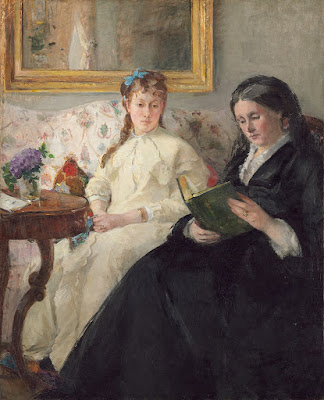Three great women painters who navigated tricky social rules before there was modern feminism.
 |
|
The Boating Party, 1893-94, Mary Cassatt, courtesy National Gallery
|
Today we look at the intimate mother-child paintings of Mary Cassatt and pigeonhole her as a woman artist, or, worse, ‘sentimental’. She would have disliked either description. She thought of herself as a New Woman, and her paintings were depictions of that ideal. Although she never married or had children, she viewed motherhood as a high calling.
 |
|
Reading Le Figaro, 1878, Mary Cassatt, private collection. The model is the artist’s mother, an educated and well-read woman who had a profound influence on the artist.
|
The New Woman was popularized by the heroines of Henry James. She controlled her own life, purse and thoughts. Mary Cassatt was not stridently political in the 20th century sense, but she depicted women and their work in a whole new way. There would be none of the bathtub voyeurism painted by her close friend and sometimes-collaborator, Edgar Degas. In short, she was a feminist and most of her fellow Impressionists were not.
Cassatt was described by critic and art historian Gustave Geffroy as one of “les trois grandes dames” of Impressionism. The other two were Marie Bracquemond and Berthe Morisot. Each chose to negotiate the difficult territory of career and family in different ways.
 |
|
Under the Lamp, 1877, Marie Bracquemond, courtesy Galleries Maurice Sternberg, Chicago
|
Marie Bracquemond was the daughter of an unhappy, arranged marriage. Her sea-captain father died shortly after her birth, and her widowed mother and stepfather were ramblers, giving her an unsettled childhood. Yet she was a prodigy. As a teenager, she began studying in a local atelier. A painting of hers was accepted into the Salon when she was just 17. She studied for a time under Jean-Auguste-Dominique Ingres, who didn’t think much of women painters.
At 29, she married fellow artist Félix Bracquemond. They’d had a passionate two-year affair, but Marie should have listened to her mother, who hated the fellow.
According to their son, Félix was resentful and critical of his wife’s painting, particularly when she began to explore Impressionism. By 1890, she was so discouraged that she gave up professional painting altogether. Despite her fragile health, she lived to 76, only outlasting her husband by two years.
 |
|
The Mother and Sister of the Artist, 1869-70, Berthe Morisot, courtesy National Gallery
|
Just as Cassatt had a deep friendship with Degas, Berthe Morisot was an intimate of painter Édouard Manet; in fact, she married his brother. Eugène Manet could not have been more different from Félix Bracquemond. Also a painter, Eugène never achieved much of a reputation, instead devoting himself to promoting his wife’s career.
Berthe Morisot was the granddaughter of Jean-Honoré Fragonard and was born into an affluent bourgeois family. Because she was very self-critical, it is difficult to trace her development and training with any certainty. She met Édouard Manet, in 1868, and married Eugène in 1874.
She first showed with her fellow Impressionists in 1874. Le Figaro critic Albert Wolff wrote that the Impressionists consisted of “five or six lunatics — among them a woman — a group of unfortunate creatures.” Morisot, he added, had a “feminine grace [that] is maintained amid the outpourings of a delirious mind.”
By the time her daughter was born in 1878, Morisot was a mature artist who was showing and selling regularly. Morisot died when Julie was just 16. She had contracted pneumonia while nursing her precious child back to health.
